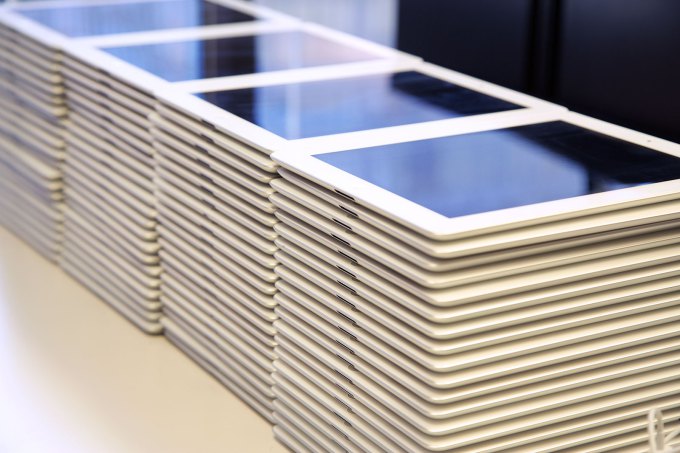Positive vs negative effects of iPads
October 23, 2015
Positive effects of iPads
Technology seems to be consuming society as it is apparent everywhere, the classroom being no exception. Within the past few years, schools have been fusing technology into their curriculum. First computers, then smartboards and now iPads. Like any new thing, there are some mixed feelings, both positive and negative, about iPads in the classroom.
There are numerous high schools across the country that have begun incorporating iPads into classroom learning. Accordingly, one of the major benefits of the iPad initiative is increasing participation among students. There are various apps educators use in the classroom, all of which engage students and increase their participation in the classroom, through interactive quizzes. For instance, Kahoot and Socrative provide fun ways to both prepare students for upcoming tests and even use as an actual test through various formats where students can “compete” to answer questions the fastest.
Similarly, there are also note taking apps, the most popular being Notability. The opportunities Notability presents are endless, from taking notes, which can be handwritten or typed, to recording lectures and doing everything in between. Due to all these features, Notability is ranked the number one notetaking app, according to laptopmag.com.
Some other effective study tools on the iPad are Study Blue and Quizlet, allowing users to create flashcards and study their vocabulary terms.
As the usage of iPads in the classroom continue, the wide variety of apps to use also increases, all of which increase student involvement in classes as students have the desire to participate in class, according to edutopia.
There are several other benefits for including iPads into the classroom. One thing that students and teachers especially like is receiving instant feedback. Whether this feedback be from a student demonstrating how well he understands the material or the feedback is from a teacher on a student’s work. The feedback can be instant.
Alongside of this, iPads allow for the smoother and faster transmission of materials through apps such as Schoology. Teachers can upload various materials onto schoology, allowing students instant access to materials, therefore drastically cutting back on the amount of paper handouts given. Another advantage of iPads are they eliminate the loosing of papers and assignments. As teacherhub states, “iPads are a very exciting and offer a novel way for using technology in the classroom.”
Furthermore, the various educational uses of iPads improve test scores, such as a study from Houghton Mifflin Harcourt in California, shows. The study reported students using iPads in the classroom, saw their various test scores increase 20% in one year compared to students using traditional textbooks
With the rise of technology, there have been many benefits in incorporating iPads into the classroom. From iPads increasing student participation levels to bettering test scores, iPads have proven to have a positive effect in the classroom.
Negative effects of iPads
As the years progress and society becomes more and more advanced, technology grows with it. And like any new thing, technology is not always what it is cracked up to be. As iPads continue to wiggle themselves into the classroom, negative effects of iPads are increasing as they range from being unreliable to distracting students.
One negative effect of using iPads in the classroom is their reliability. Most applications on the iPad require the Internet, and if the Internet is temporarily down, a major problem is created. Notably,students and teachers alike are becoming too reliant on their iPads, and probably would not know how to execute a lesson without the Internet as everything tends to rely on using/doing something online. Additionally, iPads are taking away one’s ability to think critically on the spot as he/she simply relies on his/her iPad and the Internet to look up and answer questions he/she may have. This leads to another problem– the lack of creativity and innovativeness. Before iPads, many lessons did not involve the Internet, resulting in lessons being much more creative as teachers could not simply rely on or use pre made lesson plans–they actually created their own unique lessons, although some still create their own. When iPads or the Internet is not working, frustration among teachers and students alike occur, due to not being able to execute their lessons.
Another major problem iPads create is the fact that they distract students. Many students cannot handle possessing an iPad with access to so many games and other entertaining apps. So now high school students are trusted to have an iPad with numerous distractions right in front of them and are expected to focus on their learning? This is a huge problem as it is next to impossible to supervise all the students in a class and their iPad usage, especially when the teacher is focusing on a lesson. As an article from BetaNews puts it, “Students find creative ways to distract themselves in the classroom” from playing games to watching videos.When students are distracted, their ability to learn is also compromised.
Additionally, most schools do not have the budget to provide every student with an iPad. Many families cannot afford to buy their child an iPad, especially if they have more than one student in school as iPads can range in price from $400-$900. If a family with three children were to buy an iPad for each of its students, that would cost at least $1200. Then including the various accessories, such as cases and keyboards, there is an additional $200 per iPad. Additionally are the fees for applications and textbook downloads, which will range between $85-$150, per student. Not to mention, if a student is required to use an iPad from first grade through their senior year in high school, one iPad will not last twelve years–causing students to buy at least two or three iPads throughout their academic career. As BetaNews simply shows, “iPads are extremely expensive and even more expensive to maintain.” Due to iPads being extremely expensive and expensive to maintain, many families cannot afford them.
There are also a few other negative reasons iPads are not the best for the classroom. According to Securedge Networks, typing can be extremely frustrating on iPads, due to the keyboard being on screen and smaller. Also, due to having access to a limited number of programs on the iPad such as Adobe Flash, a program many websites require, it is much harder to use various resources on iPads, such as Google Drive. Furthermore, iPads cannot support nor transport USB files, which help transfer documents from one device to another, making the documents less accessible to most students and teachers.
All in all, iPads have some very negative effects. iPads are unreliable, distract students and are unaffordable. iPads have better uses at home for pleasure than in the classroom.
Granted, iPads are a great technological advancement; however, they do not belong in the classroom.


